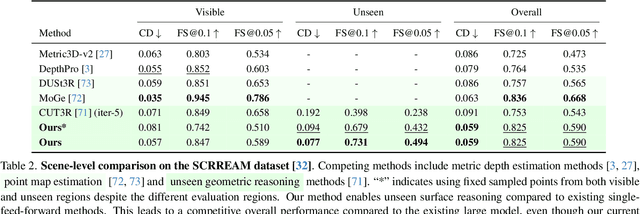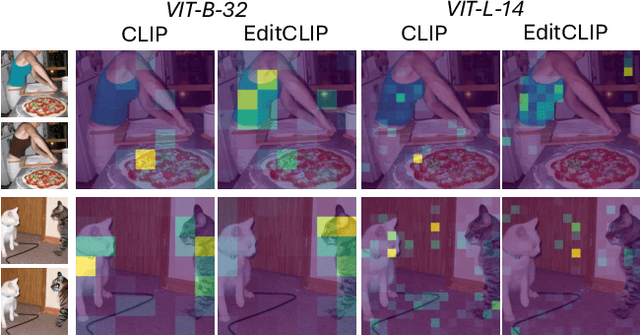Peter Wonka
KAUST
Mind-the-Glitch: Visual Correspondence for Detecting Inconsistencies in Subject-Driven Generation
Sep 26, 2025Abstract:We propose a novel approach for disentangling visual and semantic features from the backbones of pre-trained diffusion models, enabling visual correspondence in a manner analogous to the well-established semantic correspondence. While diffusion model backbones are known to encode semantically rich features, they must also contain visual features to support their image synthesis capabilities. However, isolating these visual features is challenging due to the absence of annotated datasets. To address this, we introduce an automated pipeline that constructs image pairs with annotated semantic and visual correspondences based on existing subject-driven image generation datasets, and design a contrastive architecture to separate the two feature types. Leveraging the disentangled representations, we propose a new metric, Visual Semantic Matching (VSM), that quantifies visual inconsistencies in subject-driven image generation. Empirical results show that our approach outperforms global feature-based metrics such as CLIP, DINO, and vision--language models in quantifying visual inconsistencies while also enabling spatial localization of inconsistent regions. To our knowledge, this is the first method that supports both quantification and localization of inconsistencies in subject-driven generation, offering a valuable tool for advancing this task. Project Page:https://abdo-eldesokey.github.io/mind-the-glitch/
PlanQA: A Benchmark for Spatial Reasoning in LLMs using Structured Representations
Jul 10, 2025Abstract:We introduce PlanQA, a diagnostic benchmark for evaluating geometric and spatial reasoning in large-language models (LLMs). PlanQA is grounded in structured representations of indoor scenes, such as kitchens, living rooms, and bedrooms, encoded in a symbolic format (e.g., JSON, XML layouts). The benchmark includes diverse question types that test not only metric and topological reasoning (e.g., distance, visibility, shortest paths) but also interior design constraints such as affordance, clearance, balance, and usability. Our results across a variety of frontier open-source and commercial LLMs show that while models may succeed in shallow queries, they often fail to simulate physical constraints, preserve spatial coherence, or generalize under layout perturbation. PlanQA uncovers a clear blind spot in today's LLMs: they do not consistently reason about real-world layouts. We hope that this benchmark inspires new work on language models that can accurately infer and manipulate spatial and geometric properties in practical settings.
efunc: An Efficient Function Representation without Neural Networks
May 27, 2025Abstract:Function fitting/approximation plays a fundamental role in computer graphics and other engineering applications. While recent advances have explored neural networks to address this task, these methods often rely on architectures with many parameters, limiting their practical applicability. In contrast, we pursue high-quality function approximation using parameter-efficient representations that eliminate the dependency on neural networks entirely. We first propose a novel framework for continuous function modeling. Most existing works can be formulated using this framework. We then introduce a compact function representation, which is based on polynomials interpolated using radial basis functions, bypassing both neural networks and complex/hierarchical data structures. We also develop memory-efficient CUDA-optimized algorithms that reduce computational time and memory consumption to less than 10% compared to conventional automatic differentiation frameworks. Finally, we validate our representation and optimization pipeline through extensive experiments on 3D signed distance functions (SDFs). The proposed representation achieves comparable or superior performance to state-of-the-art techniques (e.g., octree/hash-grid techniques) with significantly fewer parameters.
PlaceIt3D: Language-Guided Object Placement in Real 3D Scenes
May 08, 2025Abstract:We introduce the novel task of Language-Guided Object Placement in Real 3D Scenes. Our model is given a 3D scene's point cloud, a 3D asset, and a textual prompt broadly describing where the 3D asset should be placed. The task here is to find a valid placement for the 3D asset that respects the prompt. Compared with other language-guided localization tasks in 3D scenes such as grounding, this task has specific challenges: it is ambiguous because it has multiple valid solutions, and it requires reasoning about 3D geometric relationships and free space. We inaugurate this task by proposing a new benchmark and evaluation protocol. We also introduce a new dataset for training 3D LLMs on this task, as well as the first method to serve as a non-trivial baseline. We believe that this challenging task and our new benchmark could become part of the suite of benchmarks used to evaluate and compare generalist 3D LLM models.
LaRI: Layered Ray Intersections for Single-view 3D Geometric Reasoning
Apr 25, 2025



Abstract:We present layered ray intersections (LaRI), a new method for unseen geometry reasoning from a single image. Unlike conventional depth estimation that is limited to the visible surface, LaRI models multiple surfaces intersected by the camera rays using layered point maps. Benefiting from the compact and layered representation, LaRI enables complete, efficient, and view-aligned geometric reasoning to unify object- and scene-level tasks. We further propose to predict the ray stopping index, which identifies valid intersecting pixels and layers from LaRI's output. We build a complete training data generation pipeline for synthetic and real-world data, including 3D objects and scenes, with necessary data cleaning steps and coordination between rendering engines. As a generic method, LaRI's performance is validated in two scenarios: It yields comparable object-level results to the recent large generative model using 4% of its training data and 17% of its parameters. Meanwhile, it achieves scene-level occluded geometry reasoning in only one feed-forward.
RelTriple: Learning Plausible Indoor Layouts by Integrating Relationship Triples into the Diffusion Process
Mar 26, 2025



Abstract:The generation of indoor furniture layouts has significant applications in augmented reality, smart homes, and architectural design. Successful furniture arrangement requires proper physical relationships (e.g., collision avoidance) and spacing relationships between furniture and their functional zones to be respected. However, manually defined relationships are almost always incomplete and can produce unrealistic layouts. This work instead extracts spacing relationships automatically based on a hierarchical analysis and adopts the Delaunay Triangulation to produce important triple relationships. Compared to pairwise relationship modeling, triple relationships account for interactions and space utilization among multiple objects. To this end, we introduce RelTriple, a novel approach that enhances furniture distribution by learning spacing relationships between objects and regions. We formulate triple relationships as object-to-object (O2O) losses and object-to-region (O2R) losses and integrate them directly into the training process of generative diffusion. Our approach consistently improves over existing state-of-the-art methods in visual results evaluation metrics on unconditional layout generation, floorplan-conditioned layout generation, and scene rearrangement, achieving at least 12% on the introduced spatial relationship metric and superior spatial coherence and practical usability.
EditCLIP: Representation Learning for Image Editing
Mar 26, 2025



Abstract:We introduce EditCLIP, a novel representation-learning approach for image editing. Our method learns a unified representation of edits by jointly encoding an input image and its edited counterpart, effectively capturing their transformation. To evaluate its effectiveness, we employ EditCLIP to solve two tasks: exemplar-based image editing and automated edit evaluation. In exemplar-based image editing, we replace text-based instructions in InstructPix2Pix with EditCLIP embeddings computed from a reference exemplar image pair. Experiments demonstrate that our approach outperforms state-of-the-art methods while being more efficient and versatile. For automated evaluation, EditCLIP assesses image edits by measuring the similarity between the EditCLIP embedding of a given image pair and either a textual editing instruction or the EditCLIP embedding of another reference image pair. Experiments show that EditCLIP aligns more closely with human judgments than existing CLIP-based metrics, providing a reliable measure of edit quality and structural preservation.
iFlame: Interleaving Full and Linear Attention for Efficient Mesh Generation
Mar 20, 2025Abstract:This paper propose iFlame, a novel transformer-based network architecture for mesh generation. While attention-based models have demonstrated remarkable performance in mesh generation, their quadratic computational complexity limits scalability, particularly for high-resolution 3D data. Conversely, linear attention mechanisms offer lower computational costs but often struggle to capture long-range dependencies, resulting in suboptimal outcomes. To address this trade-off, we propose an interleaving autoregressive mesh generation framework that combines the efficiency of linear attention with the expressive power of full attention mechanisms. To further enhance efficiency and leverage the inherent structure of mesh representations, we integrate this interleaving approach into an hourglass architecture, which significantly boosts efficiency. Our approach reduces training time while achieving performance comparable to pure attention-based models. To improve inference efficiency, we implemented a caching algorithm that almost doubles the speed and reduces the KV cache size by seven-eighths compared to the original Transformer. We evaluate our framework on ShapeNet and Objaverse, demonstrating its ability to generate high-quality 3D meshes efficiently. Our results indicate that the proposed interleaving framework effectively balances computational efficiency and generative performance, making it a practical solution for mesh generation. The training takes only 2 days with 4 GPUs on 39k data with a maximum of 4k faces on Objaverse.
V2M4: 4D Mesh Animation Reconstruction from a Single Monocular Video
Mar 11, 2025



Abstract:We present V2M4, a novel 4D reconstruction method that directly generates a usable 4D mesh animation asset from a single monocular video. Unlike existing approaches that rely on priors from multi-view image and video generation models, our method is based on native 3D mesh generation models. Naively applying 3D mesh generation models to generate a mesh for each frame in a 4D task can lead to issues such as incorrect mesh poses, misalignment of mesh appearance, and inconsistencies in mesh geometry and texture maps. To address these problems, we propose a structured workflow that includes camera search and mesh reposing, condition embedding optimization for mesh appearance refinement, pairwise mesh registration for topology consistency, and global texture map optimization for texture consistency. Our method outputs high-quality 4D animated assets that are compatible with mainstream graphics and game software. Experimental results across a variety of animation types and motion amplitudes demonstrate the generalization and effectiveness of our method. Project page:https://windvchen.github.io/V2M4/.
Generative Human Geometry Distribution
Mar 03, 2025Abstract:Realistic human geometry generation is an important yet challenging task, requiring both the preservation of fine clothing details and the accurate modeling of clothing-pose interactions. Geometry distributions, which can model the geometry of a single human as a distribution, provide a promising representation for high-fidelity synthesis. However, applying geometry distributions for human generation requires learning a dataset-level distribution over numerous individual geometry distributions. To address the resulting challenges, we propose a novel 3D human generative framework that, for the first time, models the distribution of human geometry distributions. Our framework operates in two stages: first, generating the human geometry distribution, and second, synthesizing high-fidelity humans by sampling from this distribution. We validate our method on two tasks: pose-conditioned 3D human generation and single-view-based novel pose generation. Experimental results demonstrate that our approach achieves the best quantitative results in terms of realism and geometric fidelity, outperforming state-of-the-art generative methods.
 Add to Chrome
Add to Chrome Add to Firefox
Add to Firefox Add to Edge
Add to Edge